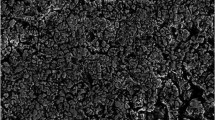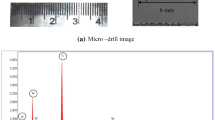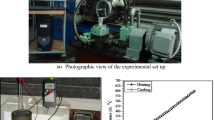Abstract
This study harnesses the Adaptive Neuro-Fuzzy Inference System (ANFIS) as a powerful tool for modelling key parameters specifically surface roughness, Metal Removal Rate (MRR), and Cutting forces pertinent to the machining of titanium alloy using a cutting-edge carbon nanotube (CNT)-infused grinding wheel. The investigation is rooted in a meticulously designed experimental framework employing a comprehensive L27 full factorial design, with the crafting of CNT-mixed grinding wheels tailored for the machining process. In the pursuit of accurate predictions, a first-order Sugeno-type fuzzy interference model is strategically employed for the estimation of output parameters. The ANFIS model is subsequently developed, drawing upon machining parameters derived from meticulously curated and trained datasets. Evaluation of prediction performance reveals testing errors that underscore the robustness of the model: 2.13% for surface roughness, 0.15% for MRR, and 4.24% for Tangential force. A comparative analysis of the ANFIS models further highlights their efficacy, showcasing high residual R2 values that affirm a robust fit with experimental data in the context of CNT grinding. This underscores the model’s capability to encapsulate the intricate dynamics of the machining process. Importantly, the proposed model exhibits significant potential for real-time estimation of surface roughness in CNT-based grinding applications, suggesting its applicability and utility in advancing the precision and efficiency of machining operations in this technologically advanced domain.


















Similar content being viewed by others
Availability of data and materials
Not Applicable.
Code availability
Not Applicable (software application or custom code).
References
Ardabili S, Beszedes B, Nadai L, Szell K, Mosavi A, and Imre F (2020) Comparative analysis of single and hybrid Neuro-Fuzzy-based models for an industrial heating ventilation and air conditioning control system. Proceedings - 2020 RIVF international conference on computing and communication technologies, RIVF 2020., (February)
Baseri H, Alinejad G (2011) ANFIS modeling of the surface roughness in grinding process. World Acad Sci Eng Technol 73(1):499–503
Dambatta YS, Sayuti M, Sarhan AAD, Ab Shukor HB, Derahman binti NA, Manladan SM (2019) Prediction of specific grinding forces and surface roughness in machining of AL6061-T6 alloy using ANFIS technique. Ind Lubr Tribol 71(2):309–317
Dao TP (2016) Multiresponse Optimization of a compliant guiding mechanism using hybrid Taguchi-Grey based fuzzy logic approach. Math Probl Eng 2016:1–17
DuyTrinh N, Shaohui Y, Nhat Tan N, Xuan Son P, Duc LA (2019) A new method for online monitoring when grinding Ti-6Al-4V alloy. Mater Manuf Processes 34(1):39–53
Huang Z, Chen S, Wang H (2018) Development of three-dimensional dynamic grinding force measurement platform. Proc Inst Mech Eng C J Mech Eng Sci 232(2):331–340
Kistler Group (2024) Multicomponent dynamometers, maximum forces up to 10 kN, cover plate 100x170 mm/9257B. https://www.kistler.com/INT/en/cp/multicomponent-dynamometers-9257b/P0000675
Kumar MPJ, Hussain JH, Anbazhagan R, Srinivasan V (2016) Effect of grinding wheel loading on force and vibration. J Chem Pharm Sci 9(2):276–279
le Chau N, Dao TP, Nguyen VTT (2018a) Optimal design of a dragonfly-inspired compliant joint for camera positioning system of nanoindentation tester based on a hybrid integration of jaya-ANFIS. Math Probl Eng 2018:1–16
le Chau N, Dao TP, Tien Nguyen VT (2018b) An efficient hybrid approach of finite element method, artificial neural network-based multiobjective genetic algorithm for computational optimization of a linear compliant mechanism of nanoindentation tester. Math Probl Eng 2018:1–19
Li Y, Shieh MD, Yang CC, Zhu L (2018) Application of Fuzzy-Based hybrid taguchi method for multiobjective optimization of product form design. Math Probl Eng 2018:1–18
Marinescu ID, Rowe WB, Dimitrov B, Inasaki I (2004) Tribology of abrasive machining processes. ISBN 0815514905
Naresh C, Bose PSC, Rao CSP (2020) Artificial neural networks and adaptive neuro-fuzzy models for predicting WEDM machining responses of Nitinol alloy: comparative study. SN Appl Sci 2(2):314
Opeyemi O, Justice EO (2012) Development of Neuro-fuzzy system for early prediction of heart attack. Int J Inf Technol Comput Sci 4(9):22–28
Patil PJ, Patil CR (2016) Analysis of process parameters in surface grinding using single objective Taguchi and multi-objective grey relational grade. Perspect Sci (neth). 8:367–369
Rao R et al (2018) Carbon nanotubes and related nanomaterials: critical advances and challenges for synthesis toward mainstream commercial applications. ACS Nano 12:11756–11784
Raykar SJ, D’Addona DM, Mane AM (2015) Multi-objective optimization of high speed turning of Al 7075 using Grey Relational Analysis. Procedia CIRP 33:293–298
Roy SS (2005) Design of Adaptive Neuro-Fuzzy Inference System for predicting surface roughness in turning operation. J Sci Ind Res (india) 64(9):653–659
Roy SS (2006) An adaptive network-based fuzzy approach for prediction of surface roughness in CNC end milling. J Sci Ind Res (india) 65(4):329–334
Sajan N, John TD, Sivadasan M, Singh NK (2018) An investigation on circularity error of components processed on fused deposition modeling (FDM). Mater Today Proc 5(1):1327–1334
Yin S, Nguyen DT, Chen FJ, Tang Q, Duc LA (2019) Application of compressed air in the online monitoring of surface roughness and grinding wheel wear when grinding Ti-6Al-4V titanium alloy. Int J Adv Manuf Technol 101(5–8):1315–1331
Funding
Not Applicable.
Author information
Authors and Affiliations
Contributions
Deborah Serenade Stephen: Grinding wheel Design, manufacturing and conducted the Grinding experimental works and reported the primary results and written original manuscript. Prabhu Sethuramalingam: Planned the whole work and Multi objective optimization was done, supervised, and corrected the main manuscript text. All authors reviewed the manuscript.
Corresponding author
Ethics declarations
Conflict of interests
The authors declare that they have no known competing financial interests or personal relationships that could have appeared to influence the work reported in this paper.
Ethical approval
Not applicable.
Consent to participate
Not applicable.
Consent to publish
Not applicable.
Additional information
Publisher's Note
Springer Nature remains neutral with regard to jurisdictional claims in published maps and institutional affiliations.
Rights and permissions
Springer Nature or its licensor (e.g. a society or other partner) holds exclusive rights to this article under a publishing agreement with the author(s) or other rightsholder(s); author self-archiving of the accepted manuscript version of this article is solely governed by the terms of such publishing agreement and applicable law.
About this article
Cite this article
Stephen, D.S., Sethuramalingam, P. ANFIS prediction modeling of surface roughness and cutting force of titanium alloy ground with carbon nanotube grinding wheel. Multiscale and Multidiscip. Model. Exp. and Des. (2024). https://doi.org/10.1007/s41939-024-00411-9
Received:
Accepted:
Published:
DOI: https://doi.org/10.1007/s41939-024-00411-9




